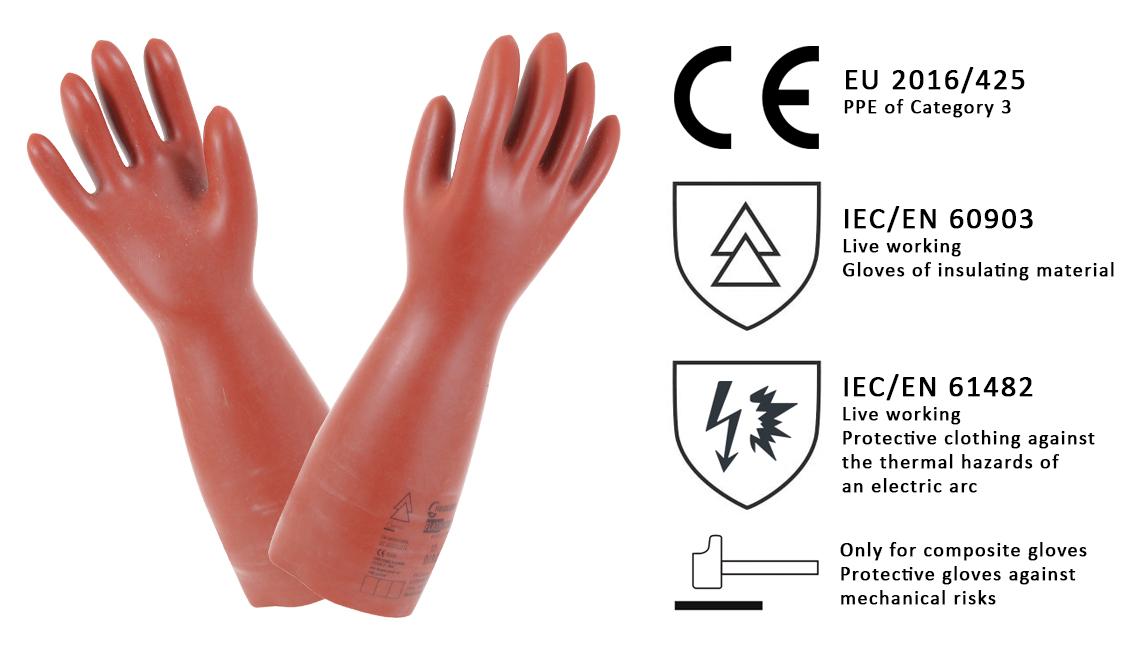
Composite insulating gloves
Composite insulating gloves with integrated mechanical protection and arc flash rating.
Composite gloves are made from a natural latex base with an outer layer of polychloroprene and combine mechanical resistance and comfort with a high protection level.
The material structure of the gloves offers short circuit electric arc protection.
Bicolored, orange outern with black inner coating.
No need to wear overgloves anymore.
Three-in-one gloves combining dielectric, mechanical and thermal (arc flash) resistance.
Each pair of composite gloves comes with a pair of cotton mittens to improve comfort.
Arircles
| Article | Class | Working voltage | Proof voltage | Category | Length | Size | Thickness | bi-color | Box test | ATPV |
|---|---|---|---|---|---|---|---|---|---|---|
| AFG36-00 | 00 | 500 V | 2.500 V | RC | 360 mm | 8,9,10,11,12 | <2,4 mm | orange/black | Class 2 (7kA/0,5s) | 26,3 cal/cm² |
| AFG41-0 | 0 | 1.000 V | 5.000 V | RC | 410 mm | 8,9,10*,11,12 | <2,9 mm | orange/black | Class 2 (7kA/0,5s) | 71,6 cal/cm² |
| AFG41-1 | 1 | 7.500 V | 10.000 V | RC | 410 mm | 8,9,10,11,12 | <3,4 mm | orange/black | Class 2 (7kA/0,5s) | 42,2 cal/cm² |
| AFG41-2 | 2 | 17.000 V | 20.000 V | RC | 410 mm | 8,9,10*,11,12 | <3,9 mm | orange/black | Class 2 (7kA/0,5s) | 74,5 cal/cm² |
| AFG41-3 | 3 | 26.500 V | 30.000 V | RC | 410 mm | 8,9,10,11,12 | <4,2 mm | orange/black | Class 2 (7kA/0,5s) | 73,2 cal/cm² |
| AFG41-4 | 4 | 36.000 V | 40.000 V | RC | 410 mm | 8,9,10,11,12 | <4,8 mm | orange/black | Class 2 (7kA/0,5s) | 87,7 cal/cm² |
Characteristics
AFG gloves are category RC gloves according to EN 60903:2003 + AC2:2005 standard and have special properties increasing their resistance to:
1. R – Category R combines the characteristics of categories:
– A – resistant to acid;
– H – resistant to oil;
– Z – resistant to ozone;
2. C – resistant to extremely low temperature.
3. Mechanical Protection
4. Arc flash protection
Conformity
1. Our gloves have been positively certified in accordance to type test procedure of EN 60903:2003 + AC2:2005, these gloves meets the applicable essential health and safety requirements included in Regulation (EU) 2016/425 of the European Parliament and of council of 9 march 2016.
2. The manufacturer declares that each individual glove introduced into the market has been positively electrically tested according to EN 60903:2003 + AC2:2005 standard.
3. Our gloves meets the requirements of harmonized standard EN 420:2003 + A1:2009 „Protective gloves. General requirements and test methods.”
Instructions
1. The use voltage of gloves shall not exceed the maximum use voltage appropriate for given class of gloves.
2. No gloves, not even those held in storage, should be used unless they have been tested within a maximum period of six months.
3. Gloves impaired or leaky shall not be used. In case of any doubts of glove’s condition it shall not be used, but shall be controlled according to periodical inspection and electrical retesting requirements. Gloves which become wet in use or by washing shall be dried thoroughly, but not in a manner that will cause the temperature of the gloves to exceed 65 °C and shall be powdered with talcum.
4. Periodic re-testing shall be performed according to requirements of EN 60903:2003 + AC2:2005.
For class 00 and class 0 gloves, a check for air leaks and a visual inspection may be considered adequate to detect cracks and damages. However, a routine dielectric test shall be performed for gloves of class 1, 2 and 3. Gloves being used intensively are recommended to be tested within 90 days.
Storage
Gloves should be stored in their original container or package at the ambient temperature between +5 °C and +35 °C in dark and dry place, not exposed to direct sunlight, artificial light or other sources of ozone. Care should be taken to ensure that gloves are not compressed or folded.
